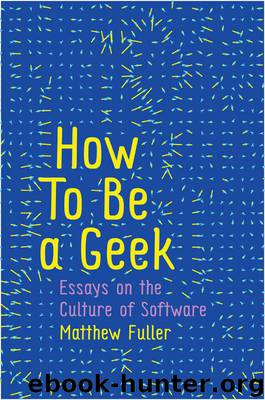How to Be a Geek by Fuller Matthew;

Author:Fuller, Matthew;
Language: eng
Format: epub
Publisher: Polity Press
Published: 2017-05-30T04:00:00+00:00
Ambiguity and Paradox
In his book How Mathematicians Think, William Byers differentiates the formalized, algorithmic means of doing maths from the moment of discovery. This is done in a somewhat different mode to Brouwer's, in that Byers aims to produce an alliance, or at least draw out affinities, between the constructivist and idealist or formalist schools through an emphasis on ambiguity; but this idea of ambiguity, one that Byers establishes through accounts and examples from many areas and ages of mathematics, is one that is also processual and experiential.
Ambiguity is a state which admits of more than one interpretation, or, more fully, of existence in a state in which, as Byers puts it, two (or more) ‘self-consistent but mutually incompatible frames of reference’19 have to be inhabited. In disciplinary terms we can think of the overlap of two not quite commensurable formalisms, such as that between logic and mathematics, or, in the example of geometry and arithmetic, fields which sometimes coincide but are not entirely mappable one to the other without causing interesting effects. As an example of such effects, one sees ambiguity in moments when the idea of a number as a quantity and as a process are linked, for instance in the number ‘one third’ being equal to 0.3 recurring in decimal notation. In the second version, knowing a number also involves calculation but requires as well a sense of the unreachable limit.20 For Byers, understanding these two forms of the number requires a creative act, one with a certain affinity to Brouwer's intuition.
Interestingly here, we are also talking about different forms of notation. There is perhaps a case for a media theory of mathematical tools allied with ethnomathematics;21 one that moves from pen and paper, to one-dimensional grids, through independent realms of abstract objects and the discourses that sustain them, to minds as putative entities, to other exciting forms of stationery.22 But to move into more fully aesthetic terms, ambiguity emerges from the existence of two or more of these interpretative states. Ambiguity is not simply something requiring the gentle discernment of nuance or the capacity to take pleasure in the multifaceted, which it certainly can be. It can also present a being with a torn and bleeding reality in which one scale of a life is incommensurable with, yet bound up with, another scale that it cannot avoid. Its painfulness may also combine with another layer, that of the joy of being able to step outside of an overdetermination. Ambiguity manifests too as the double bind or the infernal alternative, experience squeezed into systemic imperatives, as much as it does as the subtle flickering of recognition of multiply nuanced being.23 We can ask of different occurrences of ambiguity as a form of experience: how deeply can or must one inhabit ambiguity, what are its roles and latencies at different conjunctures of experience?
Given such an understanding of ambiguity, we can say that a paradox is a recursively nested ambiguity. That is, ambiguity is a statement or condition that contains the implication or fully stated condition of incompatibility with itself.
Download
This site does not store any files on its server. We only index and link to content provided by other sites. Please contact the content providers to delete copyright contents if any and email us, we'll remove relevant links or contents immediately.
The Rules Do Not Apply by Ariel Levy(4863)
Bluets by Maggie Nelson(4476)
Too Much and Not the Mood by Durga Chew-Bose(4276)
Pre-Suasion: A Revolutionary Way to Influence and Persuade by Robert Cialdini(4151)
The Motorcycle Diaries by Ernesto Che Guevara(4016)
Walking by Henry David Thoreau(3895)
Schaum's Quick Guide to Writing Great Short Stories by Margaret Lucke(3322)
What If This Were Enough? by Heather Havrilesky(3275)
The Daily Stoic by Holiday Ryan & Hanselman Stephen(3235)
The Day I Stopped Drinking Milk by Sudha Murty(3159)
The Social Psychology of Inequality by Unknown(2941)
Why I Write by George Orwell(2877)
Letters From a Stoic by Seneca(2737)
A Short History of Nearly Everything by Bryson Bill(2630)
A Burst of Light by Audre Lorde(2548)
Insomniac City by Bill Hayes(2499)
Feel Free by Zadie Smith(2436)
Upstream by Mary Oliver(2344)
Miami by Joan Didion(2324)
